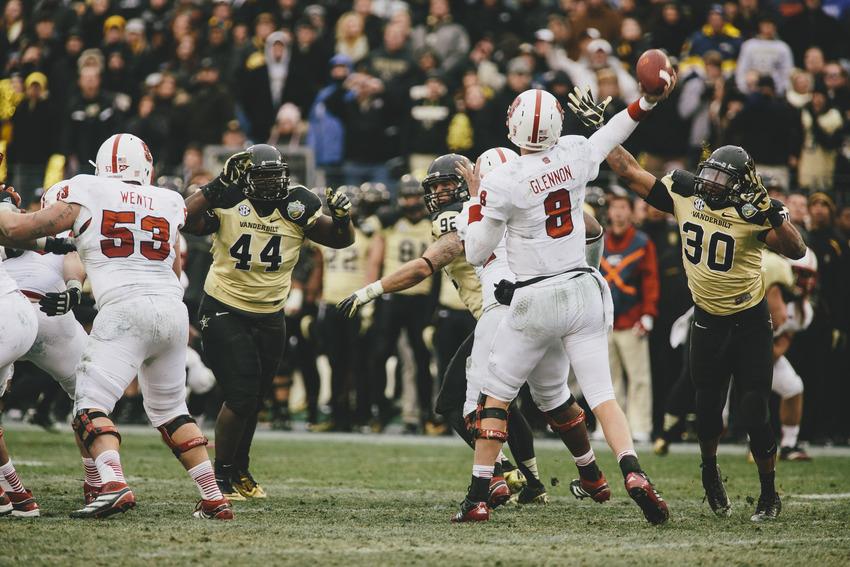With two seconds left on October 15, a crowd of 81,200 in Death Valley watched in stunned silence as North Carolina State lined up for a 33-yard field goal to win the game.
It was an opportunity for the Wolfpack to knock off third-ranked Clemson and move to 5-1, virtually cementing a bowl berth and trending upwards towards the top of the ACC. That opportunity didn’t quite play out, as Kyle Bambard’s kick sailed wide right, opening the door for Clemson to grab the win and escape undefeated. If that kick goes in, the Wolfpack are likely far, far away from Shreveport, Louisiana, this Christmas. But here we are.
Things seemed to snowball there for NC State, as it dropped its next three games, and four of their next five, making it 5-6 and on the outside looking in. For the Wolfpack, the gauntlet had been thrown down: Beat in-state rival North Carolina, and they would earn a spot in a bowl game for the third straight year.
It was a tall task, as UNC sported an 8-3 record with possible NFL No. 1 overall draft pick Mitch Trubisky at the helm, but behind 140 yards and two touchdowns from running back Matthew Dayes, NC State jumped out to a lead and never looked back. It was a huge win for a program looking to rebound from a late collapse that jeopardized their bowl chances.
If a team beating its in-state rival to earn a bowl berth sounds familiar, that’s because it is. Just look across the sidelines at NC State’s opponent this weekend. Vanderbilt closed the season out with a momentous win in Nashville over Tennessee, making it 6-6 and guaranteeing a bowl appearance.
This isn’t the only similarity between the two teams, though. The parallels don’t stop there, as Vanderbilt will be facing a team that it should recognize very well. Head coach Derek Mason already seems to have noticed.
“We’re sort of playing a twin brother in terms of how they have played,” said Mason of his team’s opponent next Monday.
Vanderbilt’s offense this season has been characterized by talent yet inconsistency at the quarterback position, aided by a strong running game, and that’s exactly what NC State brings to the table. The loss of Jacoby Brissett to the NFL left the Wolfpack with a void at quarterback, and 26 touchdowns with only 6 interceptions left big shoes to fill, but Ryan Finley started out with a bang. The Boise State transfer threw nine touchdowns in his first four games, completing 72 percent of his passes in the process.
The biggest number, however, was zero. Finley threw no interceptions in his first five games, and the lack of turnovers was a big reason why his team got off to such a hot start. When he struggled, so did NC State. In the four-game losing streak that followed, Finley threw seven interceptions, finishing that stretch and the remainder of the season with only a 55 percent completion percentage.
The running game for NC State was the picture of consistency, as Dayes eclipsed 100 yards eight times this season. Vanderbilt leaned on Ralph Webb to shoulder the load for it this season, as Webb eclipsed 95 yards eight times for the Commodores. He carried the ball 229 times for 1,172 yards and 12 touchdowns. Dayes’ numbers are strikingly similar, with 240 carries for 1,119 yards and 10 touchdowns.
Like Webb, Dayes is a shorter running back at 5’9”, but he has good patience and exceptional balance, making him difficult to bring down. Where he is most dangerous is at the second level of the defense, where his breakaway speed can turn a small hole into a big gain, something he has done time and again for this NC State team to help them win games. His skillset was on display in a matchup against Wake Forest, a game in which he rushed for 125 yards and one touchdown.
In the highlight above, Dayes gets the handoff on a play that is supposed to go right up the middle, but rather than forcing the issue, he bounces it outside and patiently waits for the hole to open. Once through the hole, he is able to break a tackle, make a move and he’s gone.
Most running backs would try to power their way through given the initial play call, but Dayes is a veteran back in this offense and understands how to pick his holes and burst through them. And if he can get past the first wave of defenders, he is a threat to take it to the house every time. Vanderbilt will certainly pose a threat with its own ground attack, but it will have to contain Dayes in order to win in Shreveport.
While the offenses are strikingly similar, and undoubtedly have their strengths, both these teams win with defense. Vanderbilt’s defense is led by Zach Cunningham, whose abilities have been well documented this season. He’s been the focal point of a defense that has stymied opposing rushing attacks, but when it comes to stopping the run, NC State does it better than almost anyone. Defensive coordinator Dave Huxtable’s group ranks fifth in the FBS against the run. Where the Commodores excel at linebacker, NC State thrives up front.
“They’re physical on defense and really good up front,” said Mason, praising his opponent’s defensive line. “That’s how we try to pattern ourselves.”
NC State is led by defensive end Bradley Chubb, a 6’4”, 275-pound Georgia native who has a team-high 9.5 sacks and three forced fumbles on the year. Chubb anchors this defensive line, as he possesses a unique combination of size and speed. He reacts to the snap as quickly as anybody in the ACC, which is what allows him to get off the line and get to the quarterback in a hurry.
However, as dynamic as Chubb is at getting to the quarterback, his speed off the line allows him to break up run plays behind the line of scrimmage, which is part of the reason why this defense is so potent against the run.
https://youtu.be/JAYGoTpmWgw?t=37m
In this highlight, Chubb diagnoses the run play and gets off the edge fast enough to make the play in the backfield to bring down Louisville’s Brandon Radcliff, a quick and shifty back who never had a chance. Plays like that, coupled with his ability to play sideline to sideline, boast an extremely rare skill set from the defensive end position. Chubb is certainly the leader of this defensive unit, one that refuses to allow big plays in the run game and can get into the backfield and create turnovers. Head coach Dave Doeren understands how his defense matches up.
“You see a lot of really good defense on film when you watch both teams,” said Doeren. “Both of us were in four-quarter games for most of the season.”
Doeren is right; these two teams kept themselves in games because of their defenses, as four out of each of their six losses were one-score games. NC State keeps its offense in games by controlling the game on the defensive side of the ball.
At Clemson, one of the best offenses in football in averaging more than 40 points per game, the Wolfpack held the Tigers to 17 points in regulation before giving up the game-winning touchdown in overtime. They were able to fend off UNC to close out the season by only allowing 21 points to one of the nation’s top quarterbacks. They held Florida State to 24 and Notre Dame to 10. This is no Alabama Crimson Tide defense, and they certainly aren’t world beaters, but the Wolfpack simply don’t allow scoring outbursts and constantly make enough plays to allow their offense to get the job done.
For these two teams, a close game is inevitable, but only one of them will be able to close it out in Shreveport and prove their worth on a national stage. Just don’t expect a shootout.



